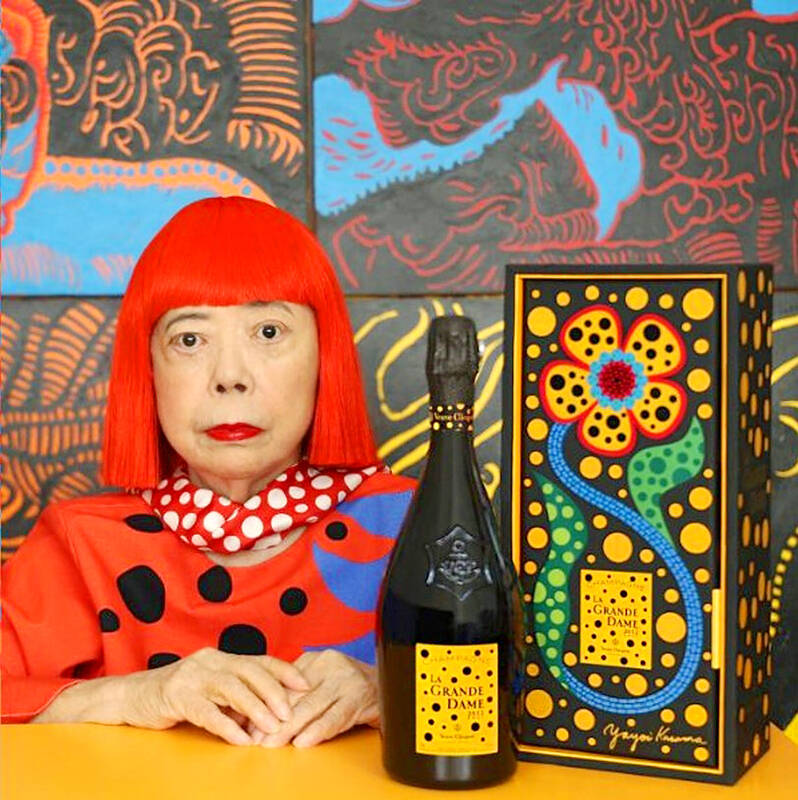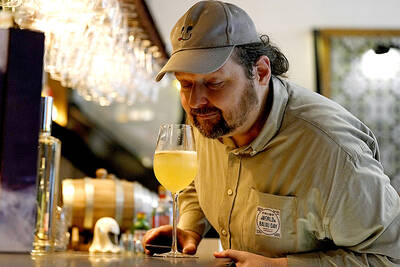Yayoi Kusama, the Japanese artist who has become an Instagram favorite in her 90s with her fantastical pumpkin sculptures, polka dots and kaleidoscopic infinity rooms, is the subject of a blockbuster retrospective heading to Australia.
In December, the National Gallery of Victoria (NGV) will present one of its most expansive exhibitions to date, with eight decades of work by Kusama — now 95 years old — on display across the gallery’s entire ground floor.
The retrospective will spill out of the gallery’s interiors and on to the Federation Court, and will include an as yet unseen Kusama installation under the cascades of the building’s familiar water wall.

Photo: Chan Shih-hung, Taipei Times
Among the 180 works on show will be at least one new “infinity mirror room”: a room of mirrors, polka dots and colored lights that reflect forever. It is these immersive kaleidoscopic works, representing Kusama’s lifelong exploration of self-obliteration and the infinity of space, that have earned her the title of world’s most Instagrammable artist.
With more than 20 mirror rooms in existence across the world, the Smithsonian’s Hirshhorn Museum in Washington DC made history in 2022 when it showed six of the rooms in the one exhibition. After seven months on display the museum was forced to extend the exhibition twice, such was the public demand.
The NGV isn’t stating definitively how many infinity rooms Melbourne will get yet, but the senior NGV curators Wayne Crothers and Miranda Wallace have suggested it will be more than six.
‘A VERY DIFFERENT PUMPKIN’
The exhibition will also give Australia its first glimpse of a newly acquired Dancing Pumpkin, one of three Kusama has recently created, the first being displayed in the New York Botanical Garden in 2021.
“It’s a very different pumpkin to the iconic pumpkin that everybody knows,” Crothers said.
“It’s a new version of the pumpkin, a huge piece which sort of lifts off the ground, almost five meters high and about seven meters across. It’s almost like a huge sort of pavilion that you can walk around underneath.”
Kusama has been painting and sculpting pumpkins since she was a child, growing up on a plant nursery and seed farm in Hirohito’s militarized Japan. It is believed the Alice in Wonderland surrealism of her work developed at a young age after she began experiencing hallucinations. According to the 2018 documentary Kusama: Infinity, the artist used art to make sense of her mental turmoil and childhood abuse.
Her obsession with self-obliteration began to mature once she arrived in New York, creating her first infinity mirror room in 1965.
The following year she invited herself to the Venice Biennale and set up what she described as her “kinetic carpet” outside the host country’s pavilion. Her Narcissus Garden, consisting of hundreds of mirrored spheres, was sold off by the artist one ball at a time for US$2 each until biennale authorities put a stop to it.
In an exhibition that pays homage to all eight decades of Kusama’s paintings, sculptures, installations, writing and activism, the NGV exhibition will include a new iteration of Narcissus Garden that will involve 1,400 reflective silver balls.
Kusama was commenting on the commercialization of art at the time, Wallace said, saying her take on Narcissus Garden for the NGV would be “a kind of new version … for the 21st century.”
THE PRICE OF ART
Visitors would be asked to donate to enable the NGV to buy the work for its collection — a strategy the gallery used in 2018 that enabled it to acquire Salvador Dali’s 1946 painting Trilogy of the desert: Mirage, costing more than US$3 million.
The nonagenarian artist will not be attending the opening of her Australian retrospective. Kusama has rarely travelled outside Japan since she voluntarily committed herself to a psychiatric facility outside Tokyo in the 1970s. She travels the short distance to her studio each day where she continues her art practice, which has been focused on painting since the early 2000s.
Works created in her childhood, and those created as recently as this year, will be included in the retrospective.
“The advantage of seeing this enormous longevity of practice is that you begin to understand how there are these connections between the works of the 1950s and 60s through to the present,” Wallace said.
“It’s an interesting journey to go on, which is why we’ve devoted the space to it. It’s an expansive story.”
Yayoi Kusama will open at the NGV on Dec. 15.

The unexpected collapse of the recall campaigns is being viewed through many lenses, most of them skewed and self-absorbed. The international media unsurprisingly focuses on what they perceive as the message that Taiwanese voters were sending in the failure of the mass recall, especially to China, the US and to friendly Western nations. This made some sense prior to early last month. One of the main arguments used by recall campaigners for recalling Chinese Nationalist Party (KMT) lawmakers was that they were too pro-China, and by extension not to be trusted with defending the nation. Also by extension, that argument could be

Aug. 4 to Aug. 10 When Coca-Cola finally pushed its way into Taiwan’s market in 1968, it allegedly vowed to wipe out its major domestic rival Hey Song within five years. But Hey Song, which began as a manual operation in a family cow shed in 1925, had proven its resilience, surviving numerous setbacks — including the loss of autonomy and nearly all its assets due to the Japanese colonial government’s wartime economic policy. By the 1960s, Hey Song had risen to the top of Taiwan’s beverage industry. This success was driven not only by president Chang Wen-chi’s

Last week, on the heels of the recall election that turned out so badly for Taiwan, came the news that US President Donald Trump had blocked the transit of President William Lai (賴清德) through the US on his way to Latin America. A few days later the international media reported that in June a scheduled visit by Minister of National Defense Wellington Koo (顧立雄) for high level meetings was canceled by the US after China’s President Xi Jinping (習近平) asked Trump to curb US engagement with Taiwan during a June phone call. The cancellation of Lai’s transit was a gaudy

The centuries-old fiery Chinese spirit baijiu (白酒), long associated with business dinners, is being reshaped to appeal to younger generations as its makers adapt to changing times. Mostly distilled from sorghum, the clear but pungent liquor contains as much as 60 percent alcohol. It’s the usual choice for toasts of gan bei (乾杯), the Chinese expression for bottoms up, and raucous drinking games. “If you like to drink spirits and you’ve never had baijiu, it’s kind of like eating noodles but you’ve never had spaghetti,” said Jim Boyce, a Canadian writer and wine expert who founded World Baijiu Day a decade